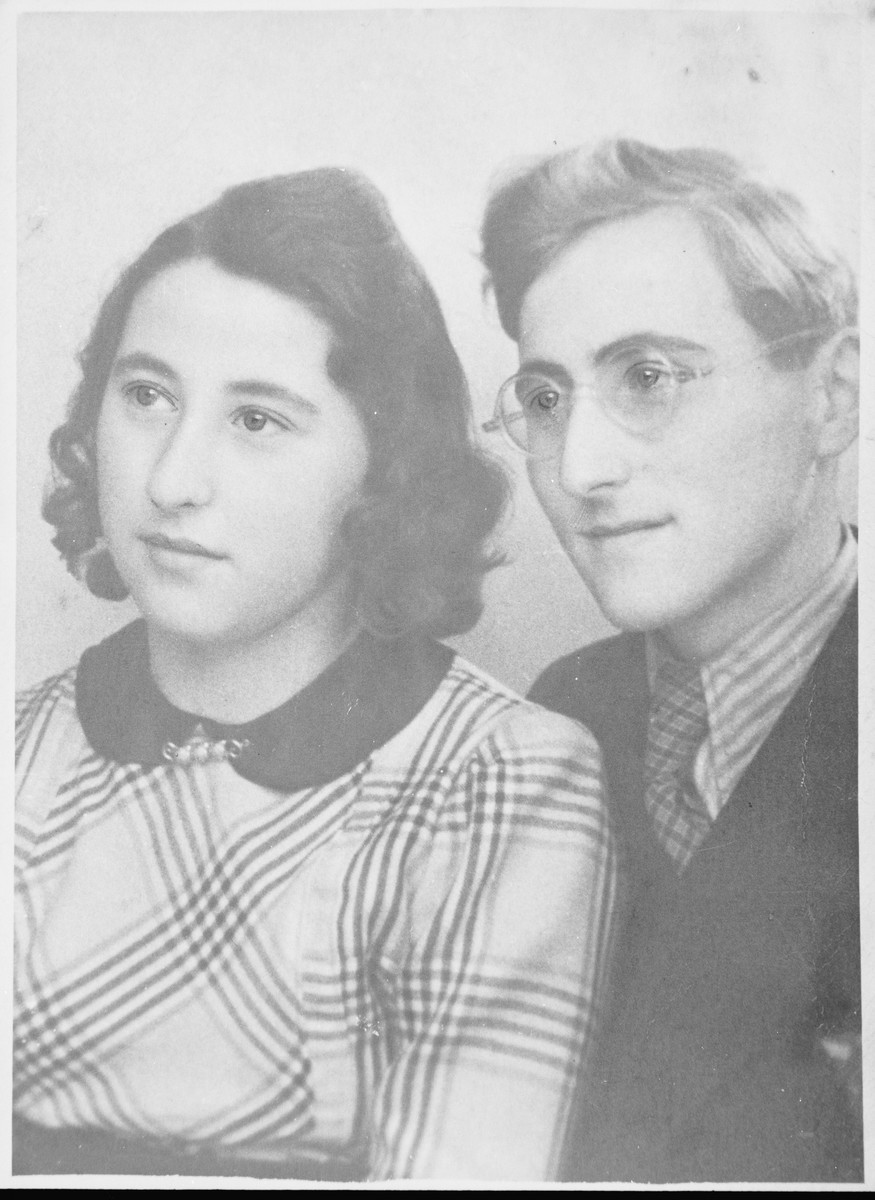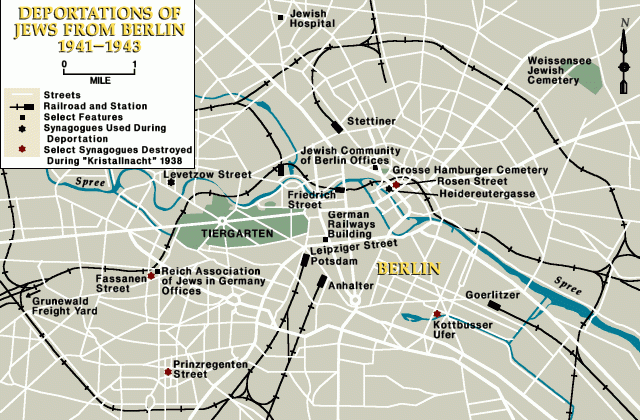
The Rosenstraße Demonstration, 1943
Background
Between February 27 and March 6, 1943, a group of up to 200 non-Jewish Germans demonstrated outside the local Jewish community building at Rosenstraße 2-4, in Berlin. There, German police had incarcerated around 2,000 Jews—mostly Jewish males married to non-Jewish partners and the male children of these so-called mixed marriages.
The non-Jewish family members of those incarcerated in the Rosenstraße believed that the Germans would deport their loved ones to the east. They based their belief on recent experiences of deportation operations and the fact that in this same period the German police rounded up and deported approximately 7,000 Jews from Berlin. Their non-violent demonstration in the freezing cold outside the Rosenstraße community center aimed to prevent this deportation.

Context
The Rosenstraße protest took place in the context of two turning points in Nazi Germany's wars: the war against the Allies and the war against the Jews of Europe.
The first turning point occurred on the military front, with the catastrophic German defeat at Stalingrad [today: Volgograd, Russian Federation]. Stalingrad raised the first significant doubts among the German people that Germany could win the war.
The second turning point was the decision of the Nazi leadership, in the wake of deporting the remainder of the German Jews to killing centers, to manage the domestic problem of Jews in “mixed marriages” and the children of such marriages.
At the Wannsee Conference in Berlin in January 1942, action again this small group of “mixed-marriage Jews” had been deferred until after Germany victory. This decision was made out of concern that the deportation of Jewish spouses and half-Jewish children would inspire unrest among non-Jewish relatives and, possibly, among broader sections of the German population.
The Factory Action [Fabrik-Aktion] and the Rosenstraße protest
Factory Action
The incarceration of Jewish spouses and Mischlinge in the Rosenstraße coincided with the last major roundup of German Jews for deportation to Auschwitz, an operation known as the “Factory Action” (Fabrik-Aktion). During this operation the Gestapo deported some 11,000 Jews to Auschwitz in the first weeks of March alone.
From the outset of the Factory Action, however, the Gestapo intended to spare the Jewish spouses and Mischlinge and move them into forced-labor camps around Berlin and other major German cities. There were some 8,800 Jews residing in Berlin who were spouses or children in “mixed marriages.” These Jews were categorized as “exempted” Jews. The Gestapo did not intend to deport these “exempted” Jews to Auschwitz or to anywhere else outside the German Reich.
Before dawn on Saturday, February 27, 1943, the Gestapo initiated their massive action. German police herded Jews, pulled from their jobs and homes or snatched off the streets, into trucks that transported them to designated assembly points. The German police incarcerated some 2,000 people in the Jewish community building at Rosenstraße 2-4, and began to check their papers to determine if they qualified as “exempted” Jews.
Protest
Family members waited in vain for the return of their spouses during the day on February 27, 1943. As word spread that some of the “mixed-marriage” Jews were in the Rosenstraße, German partners and siblings, mostly women, gathered on the street outside of the Jewish community center building. They hoped to find out information about their loved ones and to seek comfort from others in a similar situation . The building itself had been cordoned off by municipal police officers. Over the next days, the crowd swelled to between 150 and 200 persons demanding information on their loved ones.
Hoping to prevent what they believed to be an impending deportation to Auschwitz, the small crowd of civilians yelled, chanted, or remained silent but standing on the street, even when threatened with lethal force. Because of the protest's unusual character in Nazi Germany, news of the demonstration spread throughout the country and eventually, to the international press.
In addition to uncertainty about their immediate fate, those held inside the Rosenstraße community building had insufficient food and inadequate sleeping and sanitary facilities. As the spouses and other family members held their vigil outside the building, Gestapo officials continued to review papers of each internee, releasing the first “mixed-marriage” Jews as early as March 1. The review and release process continued until March 12, 1943, well after the family members had left the street on March 6.
In all, the Gestapo deported to Auschwitz 25 persons of the approximately 2,000 incarcerated in the Rosenstraße concentration center. The Gestapo designated all of them as protective custody prisoners (Schutzhäftlinge). Auschwitz camp authorities processed them into the camp as prisoners without a selection process.
Fate of the Rosenstraße Internees After Release
Release from the Rosenstraße did not end either fear or suffering for those interned there. The Gestapo followed through with its intention to deport the “mixed-marriage” Jews capable of work to forced-labor camps in Berlin and elsewhere in the Reich. German police authorities returned to pick up the released men and teenage boys on the day after their release.
Perceptions of the Rosenstraße incident

The Factory Action occurred less than a month after the surrender of the German 6th Army at Stalingrad. The timing gave the Rosenstraße incident a perceived and remembered threat of public unrest and turmoil that German authorities feared would test the tenuous wartime morale in Germany. Although on occasion individual “mixed-marriage” Jews were later deported and killed, the Nazi regime generally maintained its policy, decided upon at Wannsee, to defer deportation of “exempted” Jews to killing centers until after a German victory.
Neither those incarcerated at the Rosenstraße nor their family members, who gathered on the street in the bitter late February cold, could be certain of this, however. Their experience of deportations, including those of the ongoing Factory Action, taught that those seized were transported on trains to locations from which they never returned. Nor could the women and children gathered outside on the street be certain that the German police would be reluctant to open fire on German civilians for reasons of public relations. There had never been a demonstration on behalf of Jews in wartime Nazi Germany—there was no experience to draw upon.
Hence, nothing detracts from the courage of those women who, for the one and only time in Nazi Germany, stood face-to-face with armed municipal police officers, in the hopes of seeing their loved ones.
Conclusion
The unique circumstances of the Rosenstraße incident and its timing in relation to the deportation of Jews not in “mixed marriages” from Berlin have encouraged the development of a narrative about the protest. In this narrative, the temporary release of the “mixed-marriage” Jews from the Rosenstraße and the decision of the Gestapo not to deport them to Auschwitz to be killed are attributed to the demonstration of the women. Also in this narrative, the number of women demonstrating ranges up to 6,000. In fact, the Gestapo never intended to deport “mixed-marriage” Jews and fully intended to incarcerate these Jews in forced-labor camps in the Reich. Gestapo officials carried out their plans without reference to the events on the street outside the Rosenstraße Jewish community building between February 27 and March 6, 1943.
Critical Thinking Questions
What pressures and motivations may have influenced the actions of individual protesters?
Research news reports in both the German and international press about the demonstration.
How can societies, communities, and individuals reinforce and strengthen the willingness to stand up for others?

